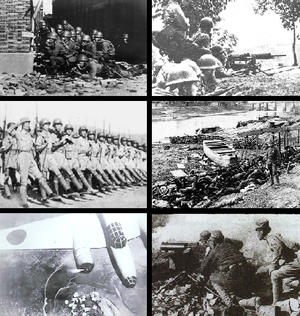War of Resistance Against Japanese Aggression
| Second Sino-Japanese War | |||||||||
|---|---|---|---|---|---|---|---|---|---|
| Part of the Pacific Theater of World War II | |||||||||
 Clockwise from top left: The Imperial Japanese Navy (IJN) Special Naval Landing Forces troops in gas masks prepare for an advance in the rubble of Shanghai, 1944 Operation Ichigo IJA Type 92 Heavy machine gun, Dead victims of the Nanking Massacre on the shore of the Qinhuai River with a Japanese soldier standing nearby, Chinese machine gun nest in the Battle of Wuhan, Japanese Bombing of Chongqing, the Chinese Expeditionary Force in India in 1942 |
|||||||||
|
|||||||||
| Belligerents | |||||||||
|
|
|
||||||||
| Commanders and leaders | |||||||||
|
|
|
||||||||
| Strength | |||||||||
|
Communist:
|
(Excluding Burma campaign and Manchuria) |
||||||||
| Casualties and losses | |||||||||
|
Nationalist: Other estimates: Communist: Other estimates: Total: 17,000,000–22,000,000 civilians dead |
Japan: Japanese record cited in western source ROC estimate: 2007 PRC studies: Collaborators: 450,000—1,000,000 military casualties after July, 1937 (Excluding Manchuria and Burma campaign) |
||||||||
![]() China
China
(Nationalist Government led a Chinese united front which included Nationalists, Communists, and regional warlords). (with foreign support)
![]() Japan (with collaborator support)
Japan (with collaborator support)
![]() Chiang Kai-shek
Chiang Kai-shek![]() Chen Cheng
Chen Cheng![]() Cheng Qian
Cheng Qian![]() Yan Xishan
Yan Xishan![]() Li Zongren
Li Zongren![]() Xue Yue
Xue Yue![]() Bai Chongxi
Bai Chongxi![]() Wei Lihuang
Wei Lihuang![]() Du Yuming
Du Yuming![]() Fu Zuoyi
Fu Zuoyi![]() Sun Liren
Sun Liren![]() Ma Hongbin
Ma Hongbin![]() Mao Zedong
Mao Zedong![]() Zhu De
Zhu De
...
Wikipedia
